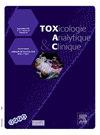液相色谱-串联质谱(LC-MS/MS)定量筛选干血斑(DBS)方法的验证
IF 1.7
Q4 TOXICOLOGY
引用次数: 0
摘要
目的建立并验证一种采用DBS的LC-MS/MS对300个化合物进行定量筛选的方法。方法取一滴血(10 μL)滴于HemaXis DB-10滤纸(HMX-DB-10)上,晾干3小时。然后通过两步液-液萃取提取感兴趣的化合物:首先在碱性环境(pH 9.7)中使用2ml的己烷/乙酸乙酯混合物(50/50),然后使用2ml的氯仿/异丙醇混合物(80/20)。上清蒸发后,用80 μL 2 mM甲酸铵(0.1%甲酸)与乙腈(50/50)的混合物复配残渣。共注入10 μL。在hyperilgold PFP色谱柱(100 × 2.1 mm, 1.9 μm)上使用梯度模式,用2 mm甲酸缓冲液(0.1%甲酸)和乙腈进行分离。使用三重四极质谱仪(TSQ Altis, ThermoFisher®)在MRM模式下进行检测。结果该方法对几种化合物进行了验证,包括传统滥用药物(可卡因及其代谢物、13种安非他明、28种阿片类药物)、NPS(12种合成苯二氮卓类药物、29种卡西酮类药物、26种合成大麻素、26种新型合成阿片类药物、其他NPS)以及几种药物类别(30种苯二氮卓类药物、37种抗精神病药物、30种抗抑郁药物、12种抗癫痫药物、18种β受体阻滞剂、8种麻醉剂、8种沙坦类药物等)。定量限(LOQ)范围为5 ng/mL(86%的化合物)~ 10 ng/mL(14%的化合物),偏差和CV≤20%。在5-10至500 ng/mL的范围内验证了线性,在准确度和精密度方面具有令人满意的性能(偏差和CV≤15%)。200 ng/mL质控分析显示准确度(偏差+精密度≤15%)。在高点(500 ng/mL)后注射的空白无结转效应。使用阴性血液样本验证了选择性,没有明显的干扰。对患者样本进行定量,并将结果与实验室常规血液筛查LC-MS/MS方法获得的结果进行比较。两种方法得到的浓度相似。稳定性、回收率和可重复性的研究正在进行中。结论DBS在毒理学分析或药物治疗监测(TDM)中的应用日益普及。这是由于几个优点:一个简化的采样程序,一个小的样品体积,和良好的分析物稳定性在这种类型的衬底。采用DBS还可以提高患者的依从性,这要归功于收集的简单性(可以由患者自己完成)、易于运输(通过邮寄)和不受限制的存储(在室温下)。此外,所需的少量血液可能是特定情况下的解决方案,例如儿科采样或多重分析,其中样本通常有限。然而,分析非常小的血容量(10 μL)是一个重大挑战,需要使用非常高灵敏度的仪器。另一个重要的限制是被分析基质的性质:全血。由于TDM主要是在血浆上进行的,因此需要开发和验证根据DBS结果预测血浆浓度的模型。血液粘度也会影响结果,因为它会影响样品的均匀性或提取效率。红细胞压积决定血液粘度,在分析验证时应评估其效果。分析技术的进步使灵敏度越来越高。结果表明DBS在治疗药物监测应用或法医毒理学方面的潜力。本文章由计算机程序翻译,如有差异,请以英文原文为准。
Validation of a quantitative screening method by liquid chromatography coupled with tandem mass spectrometry (LC-MS/MS) from a dried blood spot (DBS)
Aim
To develop and validate a quantitative screening method for a panel of 300 compounds by LC-MS/MS using a DBS.
Method
A drop of blood (10 μL) is applied to HemaXis DB 10 filter paper (HMX-DB-10) and left to dry for 3 hours. The compounds of interest are then extracted by a two-step liquid-liquid extraction: first with 2 mL of a hexane/ethyl acetate mixture (50/50) in an alkaline environment (pH 9.7), followed by 2 mL of a chloroform/isopropanol mixture (80/20). After evaporation of the supernatants, the residue is reconstituted with 80 μL of a mixture of 2 mM ammonium formate (0.1% formic acid) and acetonitrile (50/50). In all, 10 μL is then injected into the system. Separation is performed on a HypersilGold PFP column (100 × 2.1 mm, 1.9 μm) using a gradient mode with 2 mM formate buffer (0.1% formic acid) and acetonitrile. Detection is performed in MRM mode using a triple quadrupole mass spectrometer (TSQ Altis, ThermoFisher®).
Results
The method was validated for several panels of compounds, including traditional drugs of abuse (cocaine and its metabolites, 13 amphetamines, 28 opioids), NPS (12 synthetic benzodiazepines, 29 cathinones, 26 synthetic cannabinoids, 26 new synthetic opioids, other NPS), as well as several drug classes (30 benzodiazepines, 37 antipsychotics, 30 antidepressants, 12 antiepileptics, 18 β-blockers, 8 anesthetics, 8 sartans, etc.). The limits of quantification (LOQ) ranged from 5 ng/mL (86% of compounds) to 10 ng/mL (14% of compounds), with bias and CV ≤ 20%. Linearity was validated over a range of 5–10 to 500 ng/mL with satisfactory performance in terms of accuracy and precision (bias and CV ≤ 15%). Analysis of a 200 ng/mL quality control showed accuracy (bias + precision ≤ 15%). No carry-over effect was observed in blanks injected after the high point (500 ng/mL). Selectivity was verified using negative blood samples, with no significant interferences. Patient samples were quantified, and results were compared to those obtained by the routine blood screening LC-MS/MS method used in the laboratory. The concentrations obtained were similar between the two techniques. Studies on stability, recovery, and reproducibility are on going.
Conclusion
The use of DBS for toxicological analyses or pharmacological therapeutic drug monitoring (TDM) is gaining popularity. This is due to several advantages: a simplified sampling procedure, a small sample volume, and good analyte stability on this type of substrate.
The adoption of DBS could also improve patient compliance, thanks to the simplicity of the collection (which can be done by the patient themselves), easy transport (by post), and storage without constraints (at room temperature). Additionally, the small volume of blood required could be a solution in specific contexts, such as pediatric sampling or multiple analyses, where samples are often limited.
However, the analysis of very small blood volumes (10 μL) poses a significant challenge, requiring the use of instruments with very high sensitivity. Another important constraint is the nature of the matrix being analyzed: whole blood. Since TDM is primarily performed on plasma, models for predicting plasma concentrations from DBS results need to be developed and validated. Blood viscosity also affects the results, as it can impact sample homogeneity or extraction efficiency. Hematocrit determines blood viscosity, and its effect should be evaluated during analytical validation.
Advances in analytical techniques enable increasingly higher sensitivity. The results demonstrate the potential of DBS for therapeutic drug monitoring applications or forensic toxicology.
求助全文
通过发布文献求助,成功后即可免费获取论文全文。
去求助

 求助内容:
求助内容: 应助结果提醒方式:
应助结果提醒方式:


